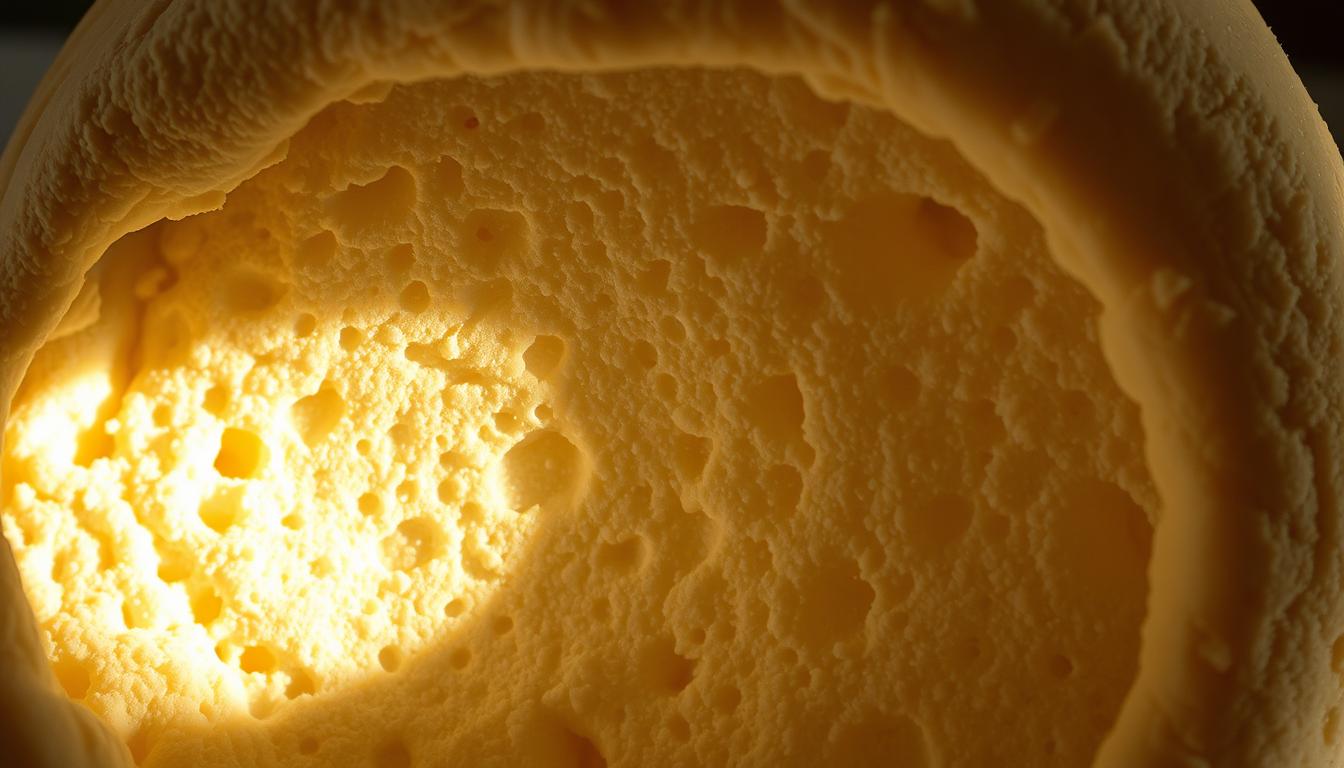Did you know one gram of active sourdough starter contains up to 100 million lactic acid bacteria and wild yeast? This bustling microbial community transforms flour and water into aromatic, airy bread through biochemical teamwork older than human agriculture.
When you mix flour with water, you awaken natural enzymes that break down starches into sugars. Your starter’s yeast feasts on these sugars, producing gas that makes bread rise. Meanwhile, bacteria create acids that develop complex flavors and preserve your loaf naturally.
You control this living system through three key factors: temperature, hydration levels, and feeding schedules. Warmer conditions speed up activity, while cooler settings let flavors deepen. The water content in your mixture determines whether you’ll get an open crumb or tight texture.
Mastering these elements helps you:
- Enhance nutritional value by breaking down gluten
- Create signature sour notes through acid balance
- Extend shelf life without preservatives
This ancient process does more than make bread rise – it’s your gateway to crafting bakery-quality results at home. Every fold and rest period shapes your final product’s character.
Key Takeaways
- Natural starters contain complex ecosystems of yeast and bacteria
- Enzyme activity converts starches into usable sugars
- Temperature directly controls microbial activity rates
- Hydration levels impact texture development
- Acid production enhances flavor and preservation
Understanding the Science Behind Dough Fermentation Explained
Every loaf begins with a hidden biochemical dance between yeast and bacteria. These microscopic partners convert basic ingredients into complex flavors through precise chemical exchanges. Let’s examine their coordinated efforts.
The Biochemical Reactions in Your Mix

Yeast cells multiply explosively under ideal conditions. A single cell can produce 20-30 identical clones through budding. This exponential growth explains how starter cultures expand from teaspoons to tons quickly.
Bacteria work differently. Without digestive systems, they release enzymes to break down starch externally. These protein catalysts convert complex carbs into simple sugars that both organisms consume.
| Microorganism | Reproduction Rate | Key Byproducts |
|---|---|---|
| Yeast | 20-30 buds per cell | CO₂, alcohol, esters |
| Lactic Bacteria | Doubles every hour | Lactic/acetic acids |
| Acetic Bacteria | Slower growth | Sharp-tasting acids |
Partners in Flavor Development
Yeast metabolites like aldehydes create buttery notes, while bacterial acids add tang. Together, they generate over 300 aromatic compounds absent in commercial breads. The yeast’s gas production lifts your loaf, while bacterial acids strengthen gluten networks.
This symbiotic relationship lets you control outcomes. Cooler temperatures favor acidic bacteria, while warmth accelerates yeast activity. Balancing these factors helps craft signature textures and tastes in every batch.
The Role of Yeast and Enzymes in Creating Perfect Dough
Your bread’s airy crumb and complex flavors emerge from precise biological teamwork. Microscopic organisms and protein catalysts transform simple ingredients through carefully timed reactions.

Gas Factories in Action
Each yeast cell acts as a miniature gas generator. When feeding on sugars, these single-celled organisms produce equal parts carbon dioxide and alcohol through anaerobic respiration. The trapped CO₂ forms bubbles that lift your mixture, while alcohol evaporates during baking, creating extra oven spring.
Warmer environments accelerate this process dramatically. At 75°F (24°C), yeast cells can double their population every 90 minutes. This explosive growth explains why temperature control proves crucial for consistent results.
Flour’s Natural Converters
Amylase enzymes break down starches into maltose, then glucose – yeast’s preferred fuel. This sugar conversion sustains gas production throughout the rising period. Without these natural catalysts, your mixture would starve its microbial workforce.
Proteases perform equally vital work by splitting gluten proteins into amino acids. These building blocks feed yeast colonies while enabling Maillard reactions during baking. British wheat varieties contain 18% more active enzymes than American counterparts, leading to faster sugar release.
| Component | Function | Impact |
|---|---|---|
| Yeast | CO₂ production | Volume & texture |
| Amylase | Starch conversion | Sustained activity |
| Protease | Protein breakdown | Flavor development |
Impact of Flour, Hydration, and Temperature on Fermentation
Your flour selection acts as the conductor of this biochemical orchestra. Different grain varieties and milling processes create unique enzymatic profiles that dictate how quickly sugars become available for yeast activity.

Enzyme Variations in Different Flours
British flours naturally contain 40% more active enzymes than their American counterparts. This stems from wheat grown in mineral-rich maritime soils, where plants develop robust enzyme systems to handle frequent rainfall. Sprouted grains take this further – their enzymes become hyperactive to support new plant growth.
Most US millers add malted barley or synthetic alpha-amylase to compensate for lower natural enzyme levels. This adjustment ensures proper starch conversion, but can’t replicate the complex flavor development of heritage British varieties.
The Effects of Hydration and Ambient Conditions
Higher water content turns your mixture into a enzyme superhighway. At 75% hydration, amylase molecules move three times faster than in stiff 60% mixtures. This rapid starch breakdown creates a sugar surplus that yeast converts to CO₂ and ethanol.
Temperature controls the gas pedal. For every 18°F (10°C) increase:
- Enzyme activity doubles
- Yeast reproduction accelerates by 150%
- Acetic acid production drops 30%
Warmer conditions (78-82°F) create rapid rises with mild flavors, while cooler environments (65-70°F) yield complex sour notes. Monitor closely – high hydration mixtures react twice as fast to temperature shifts.
Dough Fermentation Explained: Key Concepts and Processes
Bread’s journey from simple ingredients to aromatic loaf starts with a critical shift. When water meets flour, two parallel transformations begin—one visible, one microscopic. This pivotal phase sets the stage for everything that follows.

The Transition from Mixing to Fermentation
Your initial mix activates flour proteins to form gluten’s elastic network. Simultaneously, enzymes spring into action, breaking starches into sugars yeast can consume. This dual process creates structure while fueling microbial activity.
Alcoholic fermentation kicks in as yeast converts glucose and fructose into energy. For every sugar molecule processed, you get ethanol and carbon dioxide as byproducts. These substances work together—CO₂ creates air pockets, while alcohol enhances flavor development.
Room-temperature ethanol stays liquid until baking begins. When your loaf hits the oven’s heat, this alcohol vaporizes. The resulting gas expansion gives bread its final lift and open crumb structure.
Timing proves crucial during this phase. Start fermentation too early, and gluten won’t develop properly. Wait too long, and acids from bacteria might overpower subtle flavors. Monitor dough temperature closely—ideal ranges between 75-78°F balance yeast production with flavor complexity.
Successful bakers manage three key elements:
- Hydration levels that enable enzyme mobility
- Consistent warmth for steady gas production
- Proper salt ratios to control microbial speed
These factors determine whether your bread emerges dense or airy, bland or complex. Master the transition, and you unlock consistent, professional-quality results from your home oven.
Exploring Different Types of Yeast for Artisan Bread
Artisan bakers know yeast selection shapes their bread’s character. Different varieties offer unique benefits for texture, rise, and flavor development. Understanding these options helps you match microbial partners to your baking goals.
Fresh, Compressed, Frozen, and Dry Yeast Explained
Fresh yeast delivers rapid gas production but demands constant refrigeration. Also called cream yeast, it requires water dilution before mixing. Use it within two weeks for peak performance in crusty European-style loaves.
Compressed yeast contains 70% moisture. Crumble it directly into flour or dissolve in liquid. Though convenient, its short shelf life (3-4 weeks chilled) makes it less practical for home bakers.
Frozen varieties excel in pre-made doughs. Add them directly from the freezer without thawing. They maintain consistent activity for months, ideal for commercial kitchens freezing products before baking.
Dry yeast offers ultimate convenience. Active types need water activation, while instant versions mix straight into flour. Both last two years unopened at room temperature. Instant dry yeast works 25% faster than active varieties due to specialized processing.
Adjusting Yeast Quantities for Optimal Fermentation
Cold fermentation requires precise measurements. Use 1% instant dry yeast relative to flour weight. Active dry needs 1.2%, while fresh requires 3%. These ratios prevent overproofing during slow, chilled rises.
Warmer environments demand reductions. For every 15°F above 75°F (24°C), decrease yeast by 20%. This balance maintains proper gas production without sour overtones. Always check expiration dates – older yeasts need 10-15% quantity increases.
Your chosen type impacts final quality. Fresh and compressed yeasts create complex flavors but require timing precision. Dry varieties offer reliability for consistent results across varying kitchen conditions.
Techniques and Tips for Achieving Consistent, Flavorful Bread
Mastering bread-making requires precision in both technique and timing. Your control over microbial activity and gluten formation determines whether you’ll create a dense brick or airy masterpiece.
Managing Temperature and Time
Cold fermentation thrives at 24-25°C (75-77°F). Maintain this range for 12-24 hours to develop complex flavors. When using refrigerated mixtures, double proofing time to compensate for slowed yeast activity.
Surface-to-center temperature gaps in chilled mixtures demand attention. Fold low-hydration mixtures every 30 minutes to redistribute warmth. High-hydration versions need more frequent handling to prevent uneven development.
Strengthening Gluten Networks
Strategic folding creates resilient structures that trap gas effectively. This method aligns gluten strands while balancing internal temperatures. Strong networks yield better oven spring and crumb texture.
During baking, amino acids from protein breakdown react with residual sugars. This Maillard reaction creates golden crusts and rich flavors. Proper gluten development ensures these compounds form evenly throughout your loaf.
Consistency comes from understanding how time and technique interact. Adjust your approach based on hydration levels and ambient conditions. With practice, you’ll produce bakery-quality results that highlight your unique flavor profile.



